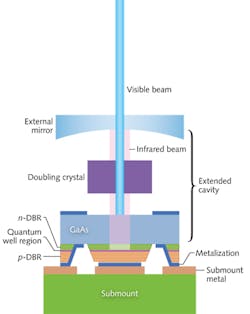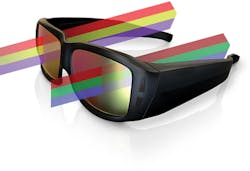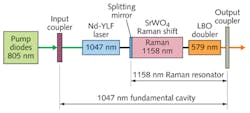Photonic Frontiers: Visible Solid-state and Diode Lasers: New options for visible solid-state and diode lasers

The award of this year's Nobel Prize in Physics to the inventors of efficient blue LEDs is a reminder of how much progress we have made on solid-state sources of visible light. I remember being amazed in December 1991 when Isamu Akasaki showed me a bright blue LED at the Materials Research Society meeting. Now you can buy violet, blue, green, and red laser pointers for just a few dollars.
Yet holes elsewhere in the visible laser spectrum remain hard—or expensive—to fill. Broad tunability, precise wavelengths needed for particular applications, and yellow or orange beams have been elusive. Fortunately, new and improved sources have emerged to fill many of those needs, reflecting engineering refinements to earlier laboratory systems as well as new research.
Tunable parametric sources
Optical parametric light sources have come a long ways since their early days in the lab. Their broad tuning range comes from using nonlinear optics to split pump photons into a pair of lower-energy (longer-wavelength) photons with frequencies called "signal" and "idler" that add to equal the pump frequency. When pumped by ultraviolet lasers, typically at 355 nm, they can span the entire visible spectrum and reach into the near-infrared. Adding optics for sum-frequency and second-harmonic generation can extend their tuning range to reach into the ultraviolet, spanning 200 to 2600 nm.
The most familiar optical parametric systems are optical parametric oscillators (OPOs) and optical parametric amplifiers (OPAs). Important variations include quasi-phase-matched (QPM) OPOs, synchronously pumped OPOs, and seeded OPAs. Parametric generation requires intense pump sources, typically megawatts per square centimeter for nanosecond OPOs and up to hundreds of gigawatts per square centimeter for femtosecond OPAs. Energetic pulsed lasers or confining pump pulses to small areas in waveguides or fibers can meet those needs.
"Parametric generation is very sensitive to pump laser performance," says Lucian Hand, president of Altos Photonics (Bozeman, MT). "Once you can make a stable pump source, an OPO becomes 'turnkey' if designed properly." He says an essential part of making a practical OPO for instrument calibration was developing a kilohertz Q-switched laser stable enough to stay within the window between efficient parametric generation and the optical damage threshold. Most visible OPOs and OPAs are pumped with the second or third harmonic from Q-switched or mode-locked solid-state lasers.
"Developments over the last decade have been more in mechanical and optical engineering than in physics," says Hand. Stabilizing optical mounts helps them withstand vibration and temperature changes; mid-infrared OPOs are used in countermeasure systems on military aircraft.1 Developers also have made the systems easier for nonspecialists to use. Much effort has gone into stabilizing optical mounts so the systems can withstand vibration and temperature changes. NIST scientists have hauled kilohertz OPOs to the top of Haleakala in Hawaii and Mount Hopkins in Arizona to calibrate telescope CCDs from 200 to 1000 nm.2,3
Doubled VECSELs for laser cinema
Fixed-wavelength coverage of the visible spectrum is spotty. The second harmonic of neodymium lasers has long been the standard source of general-purpose green light at 532 nm, and red and blue diodes are easy to find. However, other wavelengths are preferred for many applications.
Frequency-doubling near-infrared semiconductors can produce other visible wavelengths, but it requires high beam quality. That is possible with a vertical external cavity surface-emitting laser (VECSEL). Optically pumped versions, called optically pumped semiconductor disk lasers (OPSLs), with intracavity second-harmonic generation were introduced commercially at the turn of the century. Coherent (Santa Clara, CA) now offers products emitting from 355 to 639 nm.
However, electrical pumping is more attractive for applications such as RGB laser cinema projectors, says Greg Niven of Necsel (Milpitas, CA). The company uses edge-emitting diodes as blue and red emitters for laser cinema. For the green channel, however, they use electrically pumped VECSELs of the design shown in Figure 1.4 The lasers deliver the 60,000 to 72,000 lumens needed for large 3D screens, more than twice the output possible with the brightest lamps, and the lasers last 40 times longer.5
Individual doubled VECSELs can emit hundreds of milliwatts at 525 through 555 nm, so arrays can generate the hundreds of watts needed for the green channel. Using several lasers emitting at slightly different lines reduces laser speckle to the levels needed for good image quality. IMAX (New York, NY) is using Necsel's lasers for its new generation of color-based 3D projectors. They produce images for right and left eyes with distinct sets of red, green, and blue wavelengths separated by 15 to 20 nm, as shown in Figure 2. Viewers wear glasses with matching color filters for each eye, which developers say give better contrast than polarizer-based 3D.
Doubled VECSELs also can deliver other hard-to-produce wavelengths, if the application arises. "We could do yellow and orange, but have not had a customer who wants to do it yet," says Niven. Meanwhile, researchers are raising power levels attainable in the lab. Chuni Ghosh and colleagues at Princeton Optronics (Mercerville, NJ) in August reported generating 4.7 W at 531 nm by intracavity doubling with wall-plug efficiency of 18.3%, reportedly a record for an electrically pumped VECSEL.6
Raman shifting
Another approach to generating yellow, orange, or red light is by Raman-shifting the outputs of solid-state lasers to longer wavelengths, then doubling their frequency.
IPG Photonics (Oxford, MA) produces an orange laser beam by a three-stage process that involves frequency doubling the beam from a Raman fiber laser pumped by a ytterbium-fiber laser. In experiments described in 2005, D. Georgiev, V. Gapontsev, and colleagues started with 40 W at 1118 nm from a linearly polarized CW Yb-fiber laser. That laser pumped a fiber Raman laser that emitted 23 W at 1178 nm, which was frequency-doubled in periodically poled lithium niobate to generate 3 W at 589 nm.7 Their current commercial version emits up to 15 W CW at 570 to 600 nm. A similar red laser emits up to 20 W at 615 to 650 nm.
Bulk materials can produce similar effects. Y. K. Bu of Xiamen University (Xiamen, China) and colleagues Raman-shifted the 1047 nm output of a Nd-YLF laser to the 1158 nm in a strontium-tungstate (SrWO4) crystal, and an intracavity lithium-borate (LBO) crystal produced the 579 nm second harmonic, as shown in Figure 3. The researchers reported second-harmonic output to 889 mW, equivalent to 5.8% optical conversion efficiency.8
A team from Macquarie University (Sydney, Australia) and M Squared Lasers (Glasgow, Scotland) produced a peak of 0.8 W CW between 548.5 and 566 nm by doubling the Raman shifting of the output of an optically pumped VECSEL. By summing the fundamental and Raman-shifted wavelengths, the team produced up to 0.5 W in a band from 577.5 to 596 nm.9
New fundamental visible lasers
Efforts continue to develop new lasers with fundamental output in the visible. II-VI diode lasers emit in the mid-visible, but defect propagation has severely limited their lifetimes. Beryllium-zinc-cadmium-selenide (BeZnCdSe) diodes promise longer lifetimes, write S. Tanaka and colleagues at the Hitachi Central Research Laboratory (Tokyo, Japan). They have demonstrated quantum-well diodes10 with CW output above 50 mW and relatively low threshold current density of about 1 kA/cm2. Lifetimes remain to be established, however.
The rare earths praseodymium (Pr) and dysprosium (Dy) both emit on visible lines in a variety of solid-state materials, many pumped with blue InGaN diode lasers. Y. Fujimoto and colleagues at Osaka University (Japan) report that doping the ions into waterproof fluoroaluminate fibers promises higher output than conventional oxide fibers.11 Dy-doped YAG has produced peak power of 150 mW at 583 nm, limited by the brightness of the pump diode.12 Pr-doped BaY2F8 (barium-yttrium-fluoride) has emitted up to 78 mW CW at 607 nm.13 Pr-doped SrAl12O19 waveguide lasers have generated up to 1 W at 644 nm in the red and up to 36 mW at 525 nm in the green in experiments at the University of Hamburg.14
Other fundamental visible sources under study include optical pumping of solid films of organic dyes15 and colloidal quantum dots.16
Outlook
If you have been watching the development of visible lasers over the past two decades, this progress is a rapid evolution. But step back and you can see a revolution. "You're reaching basically any visible wavelength with high power and relatively low cost laser technology," says Niven. "This has not been done before, and I'm excited to see what new applications will be enabled."
The key to that success has been a combination of inspired invention, solid engineering, and serious investment. The potentially huge market for Blu-Ray HD video disks fueled millions of dollars of investment in blue diode lasers. We now have better tools to produce lasers across much of the visible spectrum, and that has brought down the size of the market needed to justify the investment in making a new wavelength. "If someone came to me and wanted to buy a hundred 2 W, 615 nm lasers a year, I could justify it," says Niven.
That kind of laser-to-order capability is indeed a revolutionary step in progress.
REFERENCES
1. J. Hecht, "Laser Countermeasures: Scaling down mid-IR countermeasures for smaller aircraft," Laser Focus World (April 2014).
2. J. L. Tonry et al., "The Pan-STARRS1 photometric system," Astrophys. J. 750, 99, (2012); doi:10.1088/0004-637X/750/2/99.
3. Y. Zong et al., "A new method for spectral irradiance and radiance responsivity calibrations using kilohertz pulsed tunable optical parametric oscillators," Metrologia 49, S124 (2012); doi:10.1088/0026-1394/49/2/S124.
4. A. Mooradian et al., "Surface emitting diode lasers and laser arrays for displays," J. Soc. Inf. Disp. 15, 805 (Oct. 2007).
5. G. Niven, W. Krupke, and W. Mackenzie, "Laser lighting revolution, coming soon to a theater near you," Optik & Photonik 5, 4, 34 (Dec. 2010).
6. P. Zhao et al., "Compact 4.7 W, 18.3% wall-plug efficiency green laser based on an electrically pumped VECSEL using intracavity frequency doubling," Opt. Lett. 39, 4766 (Aug. 2014).
7. D. Georgiev et al., "Watts-level frequency doubling of a narrow line linearly polarized Raman fiber laser to 589 nm," Opt. Express 13, 6772 (Sept. 2005).
8. Y.K. Bu, C.Q. Tan, and N. Chen, "Continuous-wave yellow light source at 579 nm based on intracavity frequency-doubled Nd:YLF/SrWO4/LBO Raman laser," Laser Phys. Lett. 8, 6, 439 (2011); doi:10.1002/lapl.201110021.
9. J. Lin et al., "Continuous-wave VECSEL Raman laser with tunable lime-yellow-orange output," Opt. Express 20 5129, (27 Feb 2012).
10. S. Tanaka et al., "Progress of Be-based II-VI green to yellow laser diodes," in CLEO-Pacific Rim (2013), paper MH2-2.
11. Y. Fujimoto et al., "Visible fiber lasers excited by GaN laser diodes," Prog. Quantum Electron. 37, 185 (2013).
12. S.R. Bowman, S. O'Connor, and N.J. Condon, "Diode-pumped yellow dysprosium lasers," Opt. Express 20, 12906 (2012).
13. D. Paboeuf et al., "Diode-pumped Pr :BaY2F8 continuous-wave orange laser," Opt. Lett. 36, 2, 280 (2011).
14. F. Reichert et al., "Efficient visible laser operation of Pr,Mg:SrAl12O19 channel waveguides," Opt. Lett. 38, 2698 (2013); doi:10.1364/OL.38.002698.
15. O. Mhibik, et al., "Broadly tunable (440-670 nm) solid-state organic laser with disposable capsules," Appl. Phys. Lett. 102, 041112 (2013); doi: 10.1063/1.4790294.
16. K. Roh et al., "Surface-emitting red, green, and blue colloidal quantum dot distributed feedback lasers," Opt. Express 22, 18800 (2014); doi:10.1364/OE.22.018800.
About the Author
Jeff Hecht
Contributing Editor
Jeff Hecht is a regular contributing editor to Laser Focus World and has been covering the laser industry for 35 years. A prolific book author, Jeff's published works include “Understanding Fiber Optics,” “Understanding Lasers,” “The Laser Guidebook,” and “Beam Weapons: The Next Arms Race.” He also has written books on the histories of lasers and fiber optics, including “City of Light: The Story of Fiber Optics,” and “Beam: The Race to Make the Laser.” Find out more at jeffhecht.com.


